
Forensic science, also known as criminalistics, is the application of science principles and methods to support legal decision-making in matters of criminal and civil law.

Authentication is the act of proving an assertion, such as the identity of a computer system user. In contrast with identification, the act of indicating a person or thing's identity, authentication is the process of verifying that identity. It might involve validating personal identity documents, verifying the authenticity of a website with a digital certificate, determining the age of an artifact by carbon dating, or ensuring that a product or document is not counterfeit.

A fingerprint is an impression left by the friction ridges of a human finger. The recovery of partial fingerprints from a crime scene is an important method of forensic science. Moisture and grease on a finger result in fingerprints on surfaces such as glass or metal. Deliberate impressions of entire fingerprints can be obtained by ink or other substances transferred from the peaks of friction ridges on the skin to a smooth surface such as paper. Fingerprint records normally contain impressions from the pad on the last joint of fingers and thumbs, though fingerprint cards also typically record portions of lower joint areas of the fingers.

Ninhydrin (2,2-dihydroxyindane-1,3-dione) is an organic compound with the formula C6H4(CO)2C(OH)2. It is used to detect ammonia and amines. Upon reaction with these amines, ninhydrin gets converted into deep blue or purple derivatives, which are called Ruhemann's purple. Ninhydrin is most commonly used to detect fingerprints in forensic cases, as the terminal amines of lysine residues in peptides and proteins sloughed off in fingerprints react with ninhydrin.

Chicago XIV is the twelfth studio album by American rock band Chicago, released on July 21, 1980. Recorded at a time of waning interest in the band, Chicago XIV remains one of Chicago's poorest-selling albums, failing to reach Gold certification by the Recording Industry Association of America (RIAA), and was deemed a commercial flop. It is also notable for being their last studio album with Columbia Records, and the last one to feature percussionist Laudir de Oliveira.

"The Adventure of the Norwood Builder", one of the 56 short Sherlock Holmes stories written by Sir Arthur Conan Doyle, is the second tale from The Return of Sherlock Holmes. The story was first published in Collier's (US) on 31 October 1903 and in The Strand Magazine (UK) in November 1903.
The Malaysian identity card is the compulsory identity card for Malaysian citizens aged 12 and above. The current identity card, known as MyKad, was introduced by the National Registration Department of Malaysia on 5 September 2001 as one of four MSC Malaysia flagship applications and a replacement for the High Quality Identity Card, Malaysia became the first country in the world to use an identification card that incorporates both photo identification and fingerprint biometric data on an in-built computer chip embedded in a piece of plastic. The main purpose of the card as a validation tool and proof of citizenship other than the birth certificate, MyKad may also serve as a valid driver's license, an ATM card, an electronic purse, and a public key, among other applications, as part of the Malaysian Government Multipurpose Card (GMPC) initiative, if the bearer chooses to activate the functions.

Thermal decomposition is a chemical decomposition caused by heat. The decomposition temperature of a substance is the temperature at which the substance chemically decomposes. The reaction is usually endothermic as heat is required to break chemical bonds in the compound undergoing decomposition. If decomposition is sufficiently exothermic, a positive feedback loop is created producing thermal runaway and possibly an explosion or other chemical reaction.

The National Registration Identity Card (NRIC), colloquially known as "IC" is the compulsory identity document issued to citizens and permanent residents of Singapore. People must register for an NRIC within one year of attaining the age of 15, or upon becoming a citizen or permanent resident. Re-registrations are required for persons attaining the ages of 30 and 55, unless the person has been issued with an NRIC within ten years prior to the re-registration ages.

Friedrich Glauser was a German-language Swiss writer.
The cast of the television series MythBusters perform experiments to verify or debunk urban legends, old wives' tales, and the like. This is a list of the various myths tested on the show, as well as the results of the experiments.
In public-key cryptography, a public key fingerprint is a short sequence of bytes used to identify a longer public key. Fingerprints are created by applying a cryptographic hash function to a public key. Since fingerprints are shorter than the keys they refer to, they can be used to simplify certain key management tasks. In Microsoft software, "thumbprint" is used instead of "fingerprint."
A device fingerprint or machine fingerprint is information collected about the software and hardware of a remote computing device for the purpose of identification. The information is usually assimilated into a brief identifier using a fingerprinting algorithm. A browser fingerprint is information collected specifically by interaction with the web browser of the device.

Hallongrotta is the name of a common Swedish cookie. The name means raspberry cave in Swedish. In the United States they are known as thumbprint cookies, as well as by many other names. Similar cookies sold in Australia are known as jam drops.
Biometrics refers to the automated recognition of individuals based on their biological and behavioral characteristics, not to be confused with statistical biometrics; which is used to analyse data in the biological sciences. Biometrics for the purposes of identification may involve DNA matching, facial recognition, fingerprints, retina and iris scanning, voice analysis, handwriting, gait, and even body odor.

The Public Prosecution Service v William Elliott and Robert McKee [2013] UKSC 32 is a case decided by the Supreme Court of the United Kingdom concerning admissibility of electronic evidence obtained from an electronic fingerprint reader unit that had not been approved by the Secretary of State as required by Article 61(8)(b) of the Police and Criminal Evidence Order 1989.
Visa requirements for crew members are administrative entry restrictions imposed by countries on members of the crew during transit or turnaround.
Glauser is a surname. People with this surname or its variants include:










